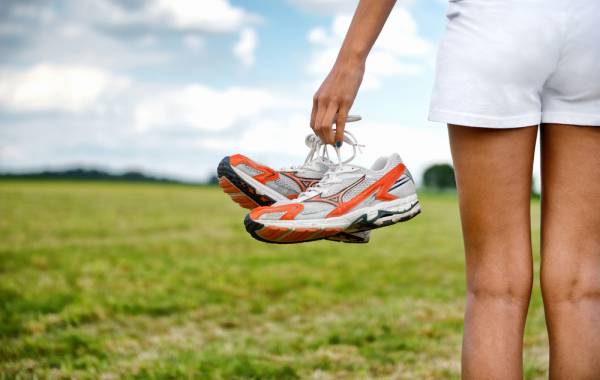In part one of this article I explained what impact forces are, why they are actually a good thing, and how shoes affect your body’s ability to perceive and receive these forces. Today, I want to explain why you get lower leg and foot injuries and how you can avoid them from happening in the first place.
First, some key points I want you to remember from part one:
In part one of this article I explained what impact forces are, why they are actually a good thing, and how shoes affect your body’s ability to perceive and receive these forces. Today, I want to explain why you get lower leg and foot injuries and how you can avoid them from happening in the first place.
First, some key points I want you to remember from part one:
- Impact is not a bad thing. It gives you energy to move. Without it, you would have to work a whole lot harder.
- You need to be able to anticipate impact, not simply react to it, in order to avoid injury and be able to use the forces as potential energy.
- Shoes or orthotics cause the muscles in your feet to get weak, lazy, and to atrophy. This influences your body’s ability to both perceive and damp vibrations.
Why Are We Getting Injured?
Now that you have a basic understanding of impact forces and what happens to our lower limbs when we heel strike, we can talk about the reasons behind the common injuries of the lower leg and foot.
Impact injures can occur for three main reasons:
- Difficultly perceiving impact
- A delayed loading response
- Poor storage potential
Like anything when it comes to the body, these are not mutually exclusive reasons. You can have difficulty with one, two, or all of these things. Let’s break each reason down a little further.
Reason 1: Difficulty Perceiving Impact
This is straightforward, and it comes right down to footwear. The more cushion you have in your footwear, the less you know how hard you are striking the ground. The less cushion, the more accurate perception you have of the vibrations coming in. Make smart footwear choices. And remember, vibration is also your energy – you want this vibration. Don’t let your shoe take it all away.
“No footwear can allow you to anticipate impact forces, even the most minimalist of shoes. Which means is if you have shoes on, you will always be reacting.”
Difficulty perceiving impact can also arise from training on different surfaces. Different surfaces vibrate at different rates. Concrete or cement is one of the worse surfaces to work on for perceiving impact as it doesn’t vibrate well. So, if you must train on less optimal surfaces, make sure you are really prepared and transition to running on them properly.
Reason 2: Delayed Loading Response
Recall how I earlier discussed the importance of anticipating and not simply reacting to impact forces? When this doesn’t occur and you simply react, this is considered a delay in your loading response. In other words, the necessary loading isn’t happening quickly enough to dampen the vibrations.
Not to sound like a broken record, but I think you can guess what the most common reason for this is: your shoes! No footwear can allow you to anticipate impact forces, even the most minimalist of shoes. Which means is if you have shoes on, you will always be reacting.

Fatigue is another reason for delayed loading response. A lot of times injuries will happen with overuse, or when pushing through fatigue. This happens because the muscles are not contracting fast or high enough, equating to a low stiffness at heel strike. This means that the compartment pressure cannot meet its peak fast enough to sufficiently damp the vibration.
Reason 3: Poor Storage Potential
Your collagen is key when it comes to having efficient movement. Collagen is a main component of our connective tissue – think tendons and ligaments. You need good collagen health. I won’t get too scienc-y here, but there are different types of collagen, and if you don’t have collagen that is elastic enough you will get micro tears. Once this happens, your body repairs it with collagen tissue that isn’t as elastic, setting the stage for a chronic issue.
Most Common Types of Impact Injuries
#1: Shin Splints
In part one, I talked about how creating compression in your lower leg is crucial to damp down the vibration. This compression also acts as a splint to the bone. If this doesn’t happen effectively, your bones will bend. As you can imagine, your bones bending is not ideal. Shin splints can occur when your tibia bends because it wasn’t effectively splinted.
#2: Achilles Tendinopathy
The Achilles tendon is the largest, strongest tendon in the body. It is continuous with the plantar fascia. Your Achilles holds most of your elastic return when you move, which means most of the potential energy is stored in that tendon. Once tendinopathy starts it can be hell to get rid of, because when we walk we take in vibrations in everything that we do.
There are two main reasons people get Achilles tendinopathies:
- You have poor fascial or connective tissue elasticity, which means you are actually creating small tears in the tissue as you move.
- You are not stiff enough on heel strike.
With regard to the second reason, it’s not just footwear that can lead to this (in other words, these injures can happen with barefoot athletes too). For example, this lack of stiffness could be due to poor movement patterns, or to an unstable core. Remember, the body works as one, and stability and motor control are dynamic (this is why you often see one-sided injuries).
“If you do decide you want to transition from wearing higher-cushioned to more minimalist style shoes, it is crucial that you do so slowly and properly.”
#3: Plantar Fasciitis
I mentioned earlier that the plantar fascia is continuous with the Achilles tendon. The same two injury reasons as above apply to plantar fasciitis, too. When you walk, your feet go through both pronation and supination, and these movements are what create the stiffness in the fascia. If the foot does not move efficiently throughout its movement, this can lead to less stiffness and more stress on the tissue.
Again, footwear can lead to these inefficient foot movement (not allowing the natural movement of your foot), as can poor motor control, or decreased strength or mobility of your feet.
How Do We Prevent These Injuries?
The most important way to prevent these injuries from occurring is to train barefoot. And I don’t mean you have to do everything barefoot, as much as I would love it if you did do that. I realize many people like to train in shoes, enjoy wearing high heels, or are simply not fans of the barefoot movement.
If this is how you feel, that is fine. But you must incorporate some barefoot training in to your other fitness programming.

As I mentioned, no footwear to date, even the most minimalist of shoes, can allow you to anticipate impact forces. Therefore, training barefoot before getting into those shoes will help prepare your foot and maintain the strength and proprioception of those muscles. And if you do decide you want to transition from wearing higher-cushioned to more minimalist style shoes, it is crucial that you do so slowly and properly. I suggest you work with a professional to help guide you through the stages of transitioning
Finally, to prevent injuries, remember to allow for surface adaptation. Know that different surfaces have different levels of vibration, and make sure you are watching and offsetting for fatigue, as well as maintaining good fascial health and flexibility.
What’s Next?
Now that you know why all of these injuries happen, and the basics of what you need to do to fix them, stay tuned for the last and final part of the series where I will give you a number of exercises and exact strategies to move more efficiently and avoid injury.
More like this:
- Impact Forces, Shoes, and Lower Leg Inuries: Part 1
- Barefoot Basics: How to Regain Your Footing
- 5 Foot Strengthening Exercises to Improve Speed, Power, and Balance
- New On Breaking Muscle Today
References:
1. Bolga, L. and Malone, T. “Plantar Fasciitis and the Windlass Mechanism: A Biomechanical Link to Clinical Practice”. Journal of Athletic Training, 39, 77-82. (2004).
Photos courtesy of Shutterstock.






